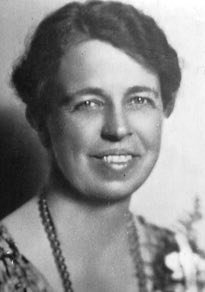As a child, Eleanor Roosevelt was made to feel that she was an “ugly duckling.” After losing both her parents, she was raised by her stern and proper grandmother, and her loneliness persisted until she was befriended by the headmistress at her boarding school. She “came out” into society, but preferred volunteer work at a settlement house to the social whirl.
In 1905 she married Franklin Roosevelt, a marriage made more complex by her domineering mother-in-law, Sara. While raising six children, Eleanor Roosevelt gradually found the determination to abandon traditional roles in favor of political and reform work. She joined the League of Women Voters, worked with trade union women, and pressed for women’s causes within the Democratic Party.
After Franklin Roosevelt was paralyzed by polio in 1921, her public activities expanded. She became his political representative, especially after he was elected governor of New York State in 1928. After her husband’s landslide election in 1932, she feared the White House might encase her in sterile protocol. But her broad sympathies and great energy created a whole new image of what a First Lady could be.
Eleanor Roosevelt held her own press conferences, toured the nation repeatedly, and pressed her opinions through newspaper columns and radio broadcasts. In the dark days of the Depression she made Americans feel that someone cared and would try to help. Even though Franklin Roosevelt did not always follow her advice, she pressed the cause of black people, youth, the poor, and the unemployed.
After her husband’s death in 1945, President Truman named her U.S. Delegate to the United Nations. The Universal Declaration of Human Rights, adopted in 1948, was largely her work, and the delegates rose in a standing ovation for her. Eleanor Roosevelt continued to be active in politics and in work for international cooperation. At a memorial service, Adlai Stevenson said: “She would rather light candles than curse the darkness, and her glow warmed the world.”

